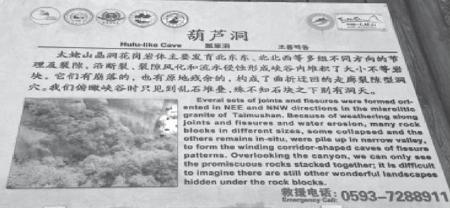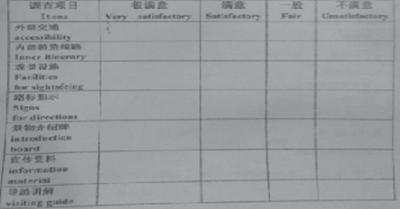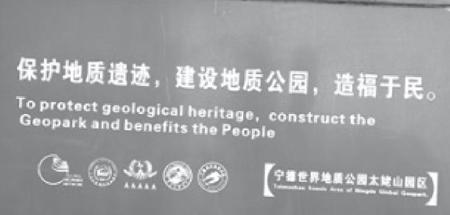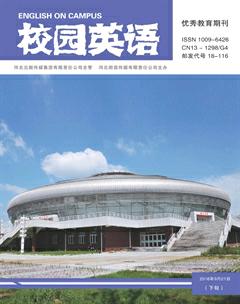Analyses on the Errors in C—E Translation of Public Signs in Scenic Spot
Fu Yuzhao You Zhuomei



【Abstract】With the establishment of a new free trade area in Fujian Province, various popular tourist sights in Ningde city are expected to receive more foreign visitors than ever before, as a consequence, the English version of public signs placed throughout all the spots has turn into an indispensable role of the endeavor to ensure the satisfaction of their leisure journeys. According to these, its urgent to conduct research on the C-E translation of public signs in scenic spots. Mistakes are found during the personal survey of Taimu Mountain, the paper gathers and corrects these misleading descriptions with care and puts forward suggestions to the relevant authorities with the best intention of improving the cultural environment and further promote its status in the world tourism industry.
【Key words】public signs; scenic spot; C-E; translation errors
1. Definition of Public Signs
Public signs, a kind of language notes that public in public places offering the public exact and helpful information to all the people, are widely applied in a variety of fields of life, especially in tourism. Public signs play a crucial part in peoples daily life. Public signs are generally referred to as “signs” in English, including public notices, advertisements, slogans and expressions on the public signs, and have been specified in various ways. It is defined in Westers New Collegiate Dictionary(1977)as a posted command, warning, or direction. In Longman Dictionary of American English(1991), sign is “a board or notice giving information, warning, etc.” Longman Dictionary of Contemporary English(1997)defines a sign as a piece of paper, metal, or wood with words or a picture that gives information, warnings, or instruction a warning, etc. In According to Oxford Advanced Learners English-Chinese Dictionary(Extended Fourth Edition)(2002: 1406), signs refer to “a board, notice, etc. That directs someone towards something, gives a warning, advertises a business, etc.” And in the sixth edition of Oxford Advanced Learners English-Chinese Dictionary(2004), sign refers to “a piece of paper, wood or metal that has writing or a picture on it that gives you information, instructions, a warning etc”.
2. Functions of Public Signs
Public signs are frequently applied in daily living, we can find that public signs are ubiquitous. The differences among the functions of public signs result in the differences between the language styles and mood in English translation of public signs
(贾文波, 2004). According to Professor Lv Hefa, there are four main functions for public signs, they are: directing, prompting, restricting and compelling (吕和发, 2004: 38).
Absolute functions include: (1) Directing is the most common function of public signs. The purpose of public signs of directing is to give information to the public, to help the public to understand their surroundings or to help people know about the situation where they are. They do not mean to prompt, to restrict or compel (邹蕴, 2012: 3-4). (2) Prompting, as the function of public signs, doesnt carry any specific meanings or significance, this kind of public signs do not demand or force readers to do something, but only to remind a fact or phenomenon (邹蕴, 2012: 3-4). (3)Public signs of restricting are used to confine or tie the tourists. The language here is direct and clear, but not to make the public feel impolite, rude, or tough. The public will accept this kind of limitation and be able to obey certain rules or regulations (邹蕴, 2012: 3-4). (4)Public signs of compelling function strictly demand the general public not to adopt certain actions. That is to say, the readers are compelled to do or forbidden from doing certain things. Public signs of compelling usually have forceful and tough tones (邹蕴, 2012: 3-4).
3. Errors Analyses of Public Signs in Ningde Global Geopark
3.1 Errors in Spelling Aspects
Spelling errors, which can also be called misspellings, are the most frequent mistakes in scenic spots and can be seen throughout in the translation of public signs. Spelling errors are mostly ascribed to the negligence of translators or signs-makers. Public signs with misspellings may not only cause severe misunderstanding, but also weaken the attractiveness of the scenic spots and leave bad impression on readers. Here are some examples for these kind of errors in Taimu Mountain:
In example 1, the author finds that the first word of the English version “Everal” doesnt exist in The Oxford Compact English Dictionary. After the authors observation, the correct word should be “Several”. (Errors in Spelling Aspects, Appendix 1)
In example 2, you can see many items below the “Items” rank; according to the writing standard of public signs, the first letter of every single word should be written in capital letter, except preposition. Capitalized words are used mostly in three places: proper names, key words in titles, and the first word of sentences. Common words used as parts of proper names are capitalized. Words derived from proper names are usually capitalized. Some proper names or their derivatives have become common words (丁往道, 吴冰, 2011). Thus this public sign lacks of standardization. (Errors in Spelling Aspects, Appendix 2)
3.2 Errors in Grammatical Errors Aspects
Grammatical errors of public signs refer to the misuse of numbers, tenses, voices, prepositions and parts of speech(柳
婧, 2012: 40). Generally speaking, grammatical errors in public sign translation are caused by the unqualified translators carelessness of the target languages grammar. Here are some examples for this kind of error in Ningde Global Geopark:
In example 3, in order to line with the previous tense, the word “benefits” should be the first person singular. Thus the correct English version of “保护地址遗迹,建设地质公园,造福于民。” should be “To protect geological heritage, construct the Geopark and benefit he people”. (Errors in Grammatical Aspects, Appendix 3)
In example 4, you can see the public sign “Keep off the Grasses”. Here, the word “grasses” is supposed to be “grass”, because the word “grass” refers to the grassland while the word “grasses” refers to a kind of plant. Thus the correct public signs should be “Keep off the Grass”. (Errors in Grammatical Aspects, Appendix4)
3.3 Errors in Pragmatic Aspects
Pragmatic failure was first presented by English linguist Jenny Thomas in Cross-cultural Pragmatic Failure in 1983. She classified pragmatic failure into pragmalinguistic failure and sociopragmatic failure. Nord (2001) points out those pragmatic translation errors are caused by inadequate solutions to pragmatic translation problems such as a lack of receiver orientation (Nord 75). According to Nord (2001), pragmatic errors cannot be detected by looking at the target text only (for instance, by a native-speaker reviser) unless they really produce incoherence in the text (Nord 76). Based on the authors observation and study on public signs in Taimu Mountain, the main errors in the C-E translation of public signs are unidiomatic expressions and word-for-word translation. Here are some examples:
In example 5, this public sign “Be careful to meet” will absolutely make foreigners feel confused and find hard to understand the real meaning. The actual meaning of “小心碰头” is to remind people to be aware of hurting their heads instead of suggesting people to meet each other carefully. It should be revised as “Mind Your Head”. (Errors in Pragmatic Aspects, Appendix5)
In example 6, the phrase “Complaint letter box” is a kind of Chinese English, the designers should avoid this kind of situation in translating. The correct expression is supposed to be “COMMENTS” or “SUGGESTION BOX”. (Errors in Pragmatic Aspects, Appendix 6)
4. Strategies for C-E Translation Problems
4.1 Domestication
Domestication is a target language culture-oriented translating method, which means that the translation should be possibly adapt to, take care of the culture of the target language habits, the clear language cultural barriers for readers. Nida, American linguist, translator and translation theorist, puts forward the term “dynamic equivalence”, is the closest natural equivalence to the source language message (Nida, 2001: 91), which contains three essential terms: (1) equivalence, which points toward the source-language message, (2) natural, which points toward the receptor language, and (3) closest, which binds the two orientations together on the basis of highest degree of approximation (Nida, 2004: 166). Example will be presented below:
In example7, the translation of “门票(全票)+往返交通车票” is “Full Entrance Fee + Shuttle bus”, the translation of “门票(半票)+往返交通车票” is “Half Entrance Fee + Shuttle bus” and the translation of “往返交通车票” is “Shuttle bus”. Foreigners are not familiar with even confused with these expressions. For instance, foreign travelers may consider the translation “Half Entrance Fee” as the price of visiting half of the tour. But they dont know the actual meaning is the price for children, students and aged people. According to the foreigners habits, the author suggests that the translations should be modified: “Full Fare” instead of “Full Entrance Fee”, “Half Fare” instead of “Half Entrance Fee” and “Transporter Fees” instead of “Shuttle bus”. (Domestication, Appendix 9)
4.2 Borrowing
Borrowing, the simplest kind of translation, which generally includes two methods, the first one is borrowing some proverbs that are commonly applied in western countries; the second is borrowing the pronunciation of some English words. Namely, we can borrow these extant English public signs sharing the same or alike meaning of Chinese in western countries. In line with Lv Hefa and Wang yings book Chinese-English Translation of Signs, we can see tremendous English public signs they take in the book, for these kinds of C-E translation public signs, we can totally adopt borrowlism (吕和发, 王颖, 2006: 67). According to the authors idea, there are at least two merits in borrowing available English public signs, practicality and conveniences. Example will be listed below:
In example 8, readers can see that the translation of “花草含羞笑 勿入草坪来打扰” is “No stepping on the green grasslands”. According to borrowing, the author advises that translators could borrow existing public sign from English countries. Thus the better version could be “Keep off the Grass”. This is because existing public signs are the simplest and the most authentic one which foreign travelers are acquainted with. Foreign travelers can easily understand the exact information that the public signs designers are going to express. Similarly, in example 13, the translator could have borrowed existing public sign “Slippery Surface” instead of translating “小心地滑” as “Carefully Slippery”. (Borrowing, Appendix 22), (Errors in Pragmatic Aspects, Appendix 10)
4.3 Amplification
Amplification, which is also called addition, is used mostly in the translation of public signs. Because of the differences in cultural background, Chinese native speakers and English native speakers have distinctive thinking or knowledge towards a same thing. According to Relevance Theory, translators should add some necessary information to help the target readers to get adequate contextual effects for realizing optimal relevance. Otherwise, the target readers can not understand such tourism public signs even with the biggest processing effort (柳婧, 2012: 40). In order to narrow the gap between foreigners and Chinese culture and to enhance the attraction of the translation, when the original text is brief, its essential to add some appropriate words on the basis of the target language. Lets see an example:
In example 9, there are just two Chinese sentences, but there is eight-line English translation. This is because the translator added some explanations of the forming reason of the scenic spot, which helped foreigners to understand the scenic spot easier. Here, the translator gave an explanation that “Planar weathering indicates a weathering type that the granite is weathered layer by layer, from the outside to inside, the weathered degree is obviously decreased, so the vertical weathered zonation is distinct.” Chinese people are familiar with the progresses that the stone formed, but foreign travelers may not know anything about them, and the explanations of the forming reason tend to be essential background for a foreign traveler to understand the tourist materials. It aims to make the translation more acceptable for foreign travelers who lack of the relevant background knowledge. (Amplification, Appendix 9)
5. Conclusion
From the above analyses, the author draws a conclusion of this paper. C-E public signs are everywhere throughout the country. With the establishment of the free trade area of Fujian, a tremendous amount of tourists across the world will flood into Ningde to have a journey. Bilingual public signs play an absolutely important role in every scenic spot. However, the quality of the public signs translation in Taimu Mountain is uneven and is not optimistic. The author completes this paper based on abundant researches and field studies. Mistakes are found during the personal survey of these scenic areas, the paper gathers and corrects these misleading descriptions with care and puts forward suggestions to the relevant authorities with the best intention of improving the cultural environment and further promote the Geo-Parks status in the world tourism industry.
Appendix
References:
[1]Nida,Eugene.Language and Culture,Contexts in Translation[M].上海外语教育出版社,2001.
[2]Nida,Eugene.Toward a Science of Translation[M].上海外语教育出版社,2004.
[3]Nord,Christiane.Translating as a Purposeful Activity:Functionalist Approaches Explained[M].Shanghai:Shanghai Foreign Language Education Press,2001.
[4]Nord,Christiane.Translating as a Purposeful Activity—Functional Approaches Explained[M].Manchester,UK:St.Jerome Publishing,1997.
[5]丁往道,吴冰.英语写作基础教程(第三版)[M].高等教育出版社,2013.
[6]戴宗显,吕和发.公示语汉英翻译研究——以2012年奥运会主办城市伦敦为例[J].中国翻译,2005(6):38-42.
[7]贾文波.功能翻译理论对应用翻译的启示[J].上海翻译,2007 (2):9-14.
[8]贾文波.应用翻译功能论[M].中国对外翻译出版公司,2004.
[9]柳婧.关联理论视角下旅游景区公示语的汉英翻译研究[D].南昌航空大学,2012:40.
[10]吕和发,单丽萍.汉英公示语词典[M].北京:商务印书馆,2004.
[11]秦莹.旅游景点公示语翻译研究[D].东北师范大学,2012:3.
[12]谭静.旅游景点公示语翻译错误分析及翻译技巧探讨[D].湘潭大学,2011:21.
[13]王颖,吕和发.公示语汉英翻译[M].北京:中国对外翻译出版社,2006.
[14]姚围围.目的论视角下的宜昌市公示语汉译英研究[D].长江大学,2014:36.
[15]邹蕴.从功能翻译理论看西安景区公示语的英译[D].西安外国语大学,2012:3-4.
[16]Net 1.Ndwssm[OL]Nov.8th,2015,from http://www.ndwww.cn/en/gygk/jianjie/201404/455824.
【基金项目】2015年度国家级大学生创新创业训练计划项目(项目编号 201510398018)。
作者简介:傅钰钊(1994-),男,福建泉州人,本科,主要研究方向为英语翻译。

